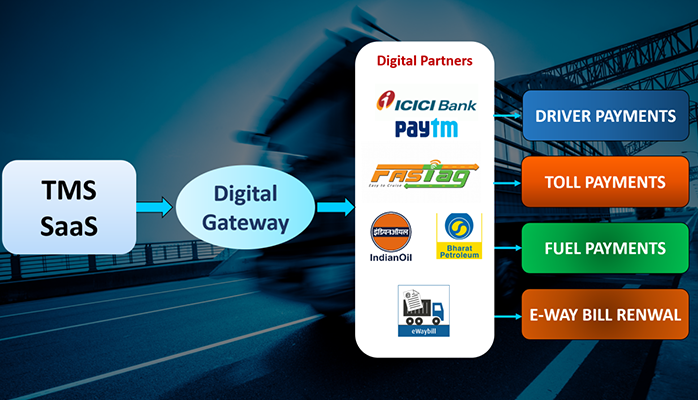
How SaaS Platforms enable Digital Ecosystem for Transporters
February 20, 2023
Time has a habit of normalizing biggest of disruptions. We are in middle of one as Covid-19 continues to spread- but that has now become the "new normal" and no longer makes headlines.
Transportation industry in India too has undergone some massive disruption. For a layman watching trucks zip across highways- everything seems same as it ever was. But go to a transporter's office and words such as e-way bill, fuel card, Fasttag, online payment are thrown around casually.
Just 5 years ago- NONE of these was common. Here is a list of disruptions since 2016:
- 2016- Demonetization kicked cash habit out, boosting fuel cards
- 2017- GST kicked out 25 plus state wide entry permits and forms
- 2018- E-way Bill ensured all movement information was digitized
- 2019- FastTag was made mandatory requiring all Toll gates to allow electronic payments
- 2019- AIS140 based GPS device was mandated for renewal of fitness certificate
- 2020- E-invoices will become mandatory from October 2020 for large companies
Today, if you want to be a transporter- you have to go digital. There is no choice. Of course, these disruptions have been tough for transport companies. Transporter has to log into multiple sites that do not talk to each others. He has to then repeat data entry across these systems. There is a good chance of mistakes and possibility of fraud has gone up.
Here is where modern Transportation SaaS based platforms come into play.
By definition, SaaS software are Cloud based and designed to communicate with multiple systems. At the core you have a Transport Management System (TMS) that manages day to day transactions- inquiry, booking, vehicle placement, delivery, billing etc.
TMS then digitally connects to multiple systems to enable seamless transactions. Here are some scenarios:
- Diesel Payment Automation: A driver calls demanding more diesel en-route. Executive at transporter office opens TMS and searches vehicle. He then adds say Rs. 20,000 to ongoing trip of the vehicle. TMS connects to Indian Oil systems and transfers this amount to Fuel Card assigned to this vehicle. As soon as card is swiped and fuel is filled, Indian Oil portal sends data back to TMS and transaction is completed
- Toll data update: A vehicle passes through a Toll Gate. Toll system recognizes the FastTag on vehicle and deducts Rs. 500 towards Toll. Data from Toll System travels back to TMS and Toll amount is updated against ongoing trip for that vehicle. No manual intervention. Also, TMS marks that vehicle has crossed a milestone in its journey and seems to be delayed. It then alerts consignee that vehicle may now reach late
- Driver payment to wallet: Vehicle breaks down on highway and driver needs to pay mechanic Rs. 35,000 for spares and services. Driver does not have spare cash so he calls his office for help. An executive opens TMS, searches for vehicle and adds Rs. 35,000 as "enroute repair expense" to the trip. TMS connects to Paytm system and transfers this amount to driver's account. Driver can now pay mechanic either by Paytm or withdrawing cash from nearby ATM.
- E-way bill auto renewal: Vehicle got delayed to to heavy rain and flooding. E-way bills for many consignment were set to expire on next day. TMS system automatically senses that over 200 e-way bill are expiring and consignment status is "not delivered". TMS calls up E-way Bill system of NIC and sends details for renewal. NIC systems adds required days to e-way bill and extends their validity. A messages is sent to transport executives informing about this renewal.
- Excessive idleness alert: Vehicle reaches factory for delivery but the factory denies entry due to document issues. The GPS device from vehicle is sending location data to TMS Control Tower. TMS senses that the vehicle is idle for long and alerts an executive. He calls up driver to find what is wrong and then calls customer to sort out the matter, ensuring unloading.
In each of above cases, multiple systems were at play and they seamlessly interacted with each other and helped transportation company to solve a problem with least human intervention and in minimum time.
That is the TRUE power of SaaS TMS. It connects to multiple systems and offers a seamless digital experience to transporters. It also ensures security as there is a SINGLE core system that automatically connects to other systems. Transporter does not need to invest in separate teams for each process and also reduces chances of fraud.
Last ten years were of disruption for transporters. Thanks to SaaS based Digital Ecosystem- they will reap benefits of these disruptions over next 10 years.
